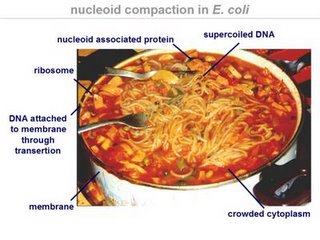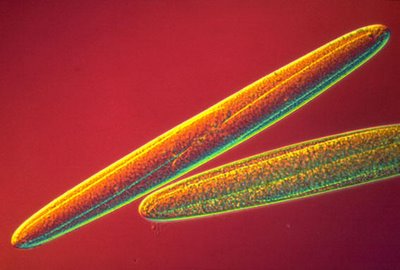As a start to this discussion forum, it's good to go to the website devoted to book
Microbe that inspired this weblog. This website is
here.
We are starting discussions with
chapter 1 of this book-
The World of Microbes.
Let's get started by posting a study question for discussion in the comments thread.
QuestionBacteria range in volume over a million-fold. Discuss some of the consequences of being larger or smaller than average?
Update of question and posting with more information to assist students. 4th March 2007 Here is some extra information that can assist students understand how size has implications for available membrane surface area to service the metabolic requirement of a unit cell volume.
To understand the point of the question about size, students need to think about have the ration of surface are:cell volume changes with increase in size. SA/Vol Ratio~diameter squared/diameter cubed~inversely proportional to diameter, with similar cell shapes.
To see some consequencences raised by the biology of large bacteria you need to read about observations that have been made on
Epulopiscium bacteria, usually called epulos. The paper by K D Clements and S Bullivant (1991)
An unusual symbiont from the gut of surgeonfishes may be the largest known prokaryote. J Bacteriol. 1991 September; 173(17): 5359–5362 provides some good interesting insights.
Figure 1 of this paper shows how large epulos are.
J Bacteriol. 1991 September; 173(17): 5359–5362. Figure 1.
Light micrograph of an Epulo. The letter C indicates a smaller, eukaryotic ciliate.J Bacteriol. 1991 September; 173(17): 5359–5362. Figure 3.
Electron micrograph of a thin section of an Epulopiscium bacterium showing concolutions to cytoplasmic membrane. Such convolutions would increase the membrane area to cell volume ratio of these large bacteria
Thus epulos have a peripheral layer of highly convoluted cytoplasmic membrane - which has been interpreted as a mechanism increase in membrane area to
compensate for some surface area to volume related challenges that they face because of their large size.
Extra reading for the high achieving student:In the links at the
Microbe Chapter 1 webpage,
this is worth studying several times in the course.
Labels: Diversity, physiology, prokaryotes, structure



